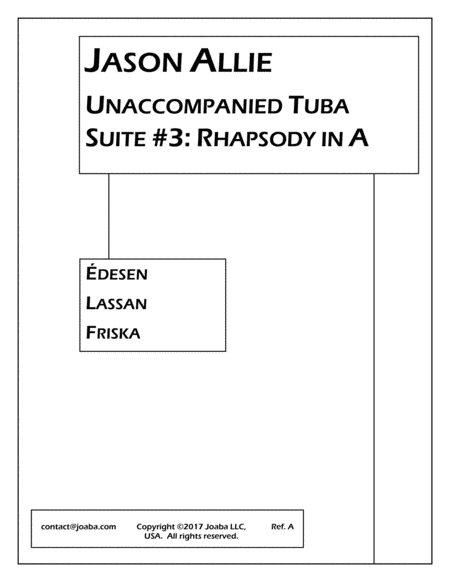Tuba Solo - Level 5 - Digital Download SKU: A0.991806 Composed by Jason Allie. Romantic Period,World. Individual part. 14 pages. Joaba LLC #3129601. Published by Joaba LLC (A0.991806). Description Total Duration: 11 minutes. A vigorous, advanced level work suitable for encouraging students, hobbyists and professionals to improve or show off their performance skills. In an enjoyable and delightful manner, tubists will build dexterity, endurance, expressiveness, effective volume and range (going up to D/C# above the staff). This work will charm, captivate, and rouse/impress audiences. A great recital piece or encore piece to show off the melodiousness, harmoniousness and vibrancy of the tuba in whole or in part. Please send feedback, praises and more to contact@joaba.com. Performance Notes from the Composer Édesen Édesen translates to sweetly in Hungarian, and is this movement’s purpose: to be a centering, calming moment before the following tumult.The first 10 bars serve as an introduction to warm up to the melody. The melody has three contrasting articulations that must be respected: staccato, legato, and normal. The melody easily leads to high and low range notes-excellent for beginner/intermediate tubists to expand and solidify their range. Give more air for the range’s extremities so pitches don’t become too thin or muddled. The second theme in the dominant (E major) should be played with luscious legato and bright staccato. LassanLassan translates to slowly in Hungarian usually conveying stateliness or seriousness. This argumentative movement breaks the former’s idyll and sets the case for the next movement’s defiance and victory.The first section is to be played serious and strong. Increase air support for the higher pitches. Make the descending scales resound and bounce off the lowest notes. The second theme starting at 81 should be played with great charm and ease. For the solo passages, show-off but slow the tempo into the fermatas: (m77-80, m102-103, and m132-133). Friska Friska translates to fresh in Hungarian and in this case, it’s a duality of turbulence and final elation.Start the piece fast, but not too boisterous-embellishments are added in the repeat demanding boisterousness. Epitomizing the turbulence, the con moto sections (at m161 & m260) emphasize a 1 beat per measure feel-accelerate the tempo as is comfortable. The digressionary, crab-like sections (at m176 & m275) should be played as light as possible to help build up to the elated sections. The first elated section (m188) should be played as if gleefully discovered but not yet won; the second elated section (m291), with a victorious finality that cannot be diminished or tarnished.
